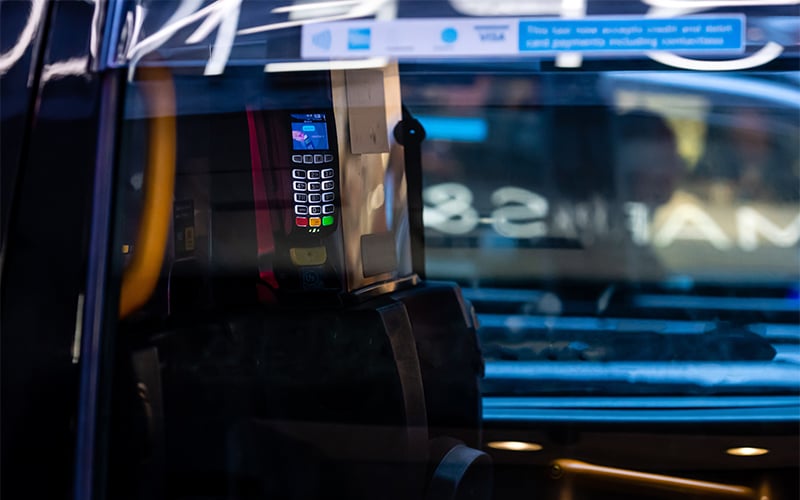The Future of Cashless Payments in Taxis

With contactless payments now the most popular payment method across the retail industry, could cashless methods become more popular in the taxi trade? In this article, we take a look at the rise of cashless payments.
- Since the COVID-19 pandemic, many customers have continued to pay cashless using a credit or debit card with most transactions now taking place in this way.
- According to UK Finance, contactless payments now make up more than a quarter of all payments in the United Kingdom.
- Cashless payments are favoured for their convenience and flexibility, with customers now being able to pay using their phone or a digital wallet.
- Operating a cashless taxi service could benefit both you and your passengers in several ways and could be worth considering as part of your service.
Table of Contents
1. How are digital payments taking over the taxi industry?
2. Benefits of digital payments for taxi drivers
3. Benefits of digital payments for taxi passengers
4. How do taxi drivers go cashless?
5. Cities that require card payments for taxis
6. The future of payments in the taxi industry
We can all appreciate the ease of tapping your debit card on a card reader when paying for lunch or shopping. It’s a lot easier than digging around in your wallet for change!
Contactless payments appear to be a hangover from the COVID-19 pandemic when many businesses stopped taking cash to avoid spreading the virus.
Post-pandemic however, they are still here and thriving, with many of the UK’s customers making payments using a card, digital wallet, or smartphone. Though what about when this comes to paying for a taxi?
How are digital payments taking over the taxi industry?
Responding to the demand for more flexible payment options, taxi companies have started to introduce digital payment facilities in cabs.
These use devices like smartphones, tablets, and even wearable devices like smartwatches to allow customers to make payments, with the help of Near Field Communications (NFC) and Quick Response (QR) codes.
These offer greater convenience for taxi customers, allowing them to pay for their taxi in just a few taps. It’s also one way of improving your customer service to give your passengers a better experience.
Not to mention the other benefits to both driver and passenger, which we’ll come onto next.
Benefits of digital payments for taxi drivers
As a taxi driver or company, offering digital payments for customers brings you several benefits to help make your work life easier:
- Decreased security risk, reducing the need for drivers to carry around large amounts of cash (which often makes drivers a target for robberies)
- Peace of mind for operators against fraudulent drivers and theft on the job
- An easier way to process payments without having to handle cash manually and carry change
- Assurance that you will be paid promptly for each fare without having to rely on your fleet manager
- Increase customer satisfaction rate at the end of a journey and make them more likely to use your services again
- Attracting additional customers with the reassurance that card payments are accepted and make them more likely to use your service
Benefits of digital payments for passengers
For passengers, there are also several benefits to be had from having access to contactless payment methods in taxis:
- Added convenience without the need to carry cash or worry about having the correct change
- Ability to manage and track transactions on their mobile banking app or in a digital wallet
- Freedom to break down payments and leave a tip if desired at the end of the trip

Convenience is definitely the key benefit here. Customers love the flexibility and ease of access that electronic payments provide, and this will especially come in handy if they just so happen to forget cash!
How do taxi drivers go cashless?
If you’re a taxi driver and are interested in providing cashless payment options for your passengers, then you’ll be curious about the process and what’s needed.
As an owner driver or self-employed taxi driver, you’ll have the flexibility of choosing whichever system works best for you, which you can find out more about at MyPos.
If you drive for a taxi firm, then introducing digital payment methods will largely be down to your operator, as they will need to pay for and install the services needed for you to offer these transactions.
They will need to set up an account with a card payment provider and order card machines to be distributed to you and other drivers in your company.
Once you get your card reader set up, it will be relatively simple to use. To take cashless payments from passengers, you’ll need to:
- Make sure the card reader is switched on
- Follow any on-screen instructions to make sure the reader is ready to take payments
- Offer the card machine to passengers and allow them to either enter their PIN or tap their contactless chip
Note that with PIN transactions, the customer will need plenty of time to securely enter their passcode and you may have to wait for the transaction to go through.
For contactless payments, however, these should be practically instant and you’ll usually hear a short beep when the payment goes through.
You may need to charge your terminal at the end of your shift to make sure it is ready to use for your next workday. This can be done using the supervisor card which should have been sent with your card machine.
Cities that require card payments for taxis
Since 2016, Transport for London (TfL) has required all licensed taxis to offer card payment devices, with other areas having followed suit, including:
- Birmingham
- Liverpool
- Chelmsford
- Oxford
According to payment provider MyPos, in places where accepting card payments is compulsory drivers will need to display a sticker in their vehicle so that customers are aware this is an option.
London cabbies also need to make sure that receipts can be printed upon request for customers using their cards to make a payment.
The future of cashless payments in the taxi industry
It may not be compulsory across the UK just yet, but the demand for cashless payments in taxis is predicted to rise.
In fact, MyPos reports that these are expected to rise to 91% in 2028, meaning the days of cash payments in taxis may be coming to an end.
We hope you’ve found this article useful and know all you need to know about contactless payments and the benefits to your business.
Looking for a new taxi before updating your payment options? We can help! Check out our special offers page for our latest deals to help you save money. Or view our range of new taxis for sale if you need some inspiration.
